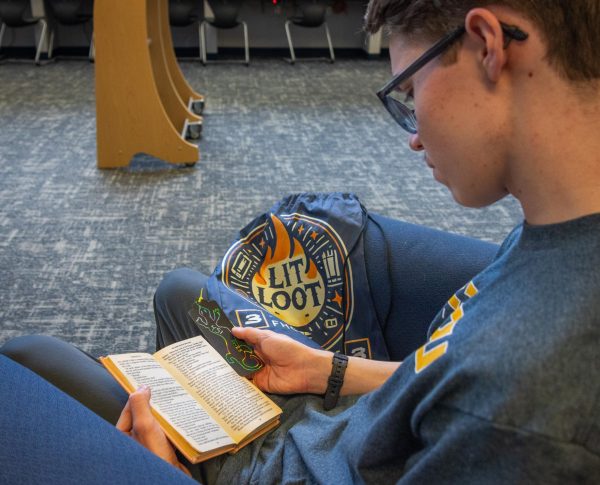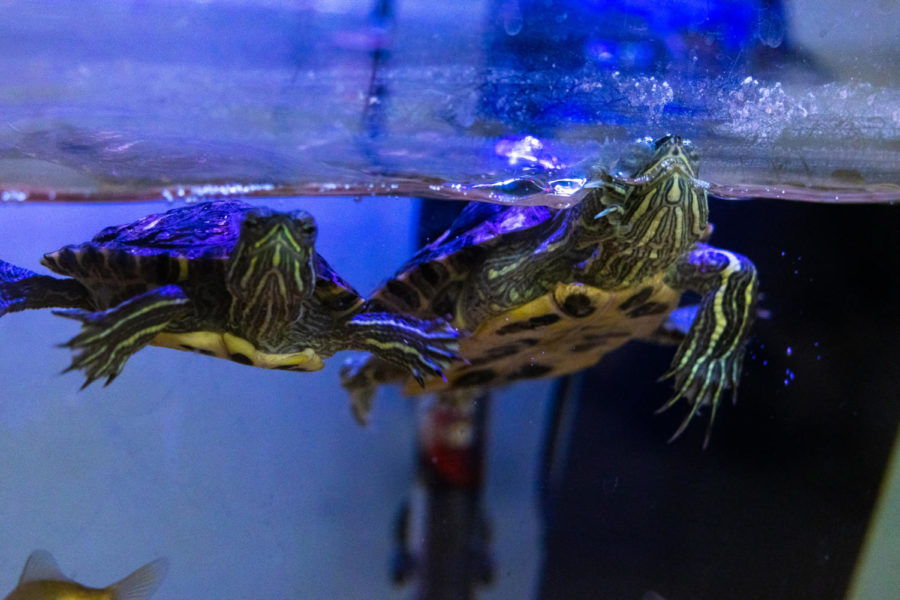Up Against The Glass
Franklin and Chad eagerly swim towards the glass as they notice people entering the classroom. Photo taken by Kyly Jacobs.
Entering Room 221 during the school week, students may notice people flocking around Kelly Staback’s tank as Taylor Spies [ Long term maternity substitute teacher for Mrs. Staback] wraps up a presentation for her Environmental Science class. Two pet turtles, one named Franklin, the other named Chad, have begun to garner the attention of students who filter their way through her classroom. Recent increases in the amount of class pets found throughout the school has sparked important discussions about the value of having pets in the classroom.
Ms. Spies has been hard at work attempting to create a positive learning environment in which students don’t feel stressed while learning. Bringing Franklin and Chad in to be class pets has proven to be an effective method of encouraging such an environment.
“Mrs Staback so nicely went on maternity leave and I took over for her. At the end of last year, her TA or my current TA decided to make this presentation, essentially asking ‘Hey, can I bring in my turtles because when I go off to college, I will not be able to bring them’ and she agreed and everything was fine,” Ms. Spies said.
Seeing Franklin and Chad every day has positively impacted many students who get to visit them in class daily. Ms. Spies enjoys seeing how struggling students benefit from having Franklin and Chad in her classroom.
“Honestly, I think it is something that brightens up all the students’ days. I see them come in from a long weekend and a Monday where it’s really rough. And then they just see those turtles swimming and it seems to really just like give them something to look forward to that maybe they wouldn’t have,” Ms. Spies said.
Senior Marissa Wortkoetter can see how people could have trouble differentiating Franklin and Chad’s appearances. Here’s how she personally is able to distinguish them apart from one another.
“ Chad is larger, he is two years older than Franklin, so franklin is much smaller. Franklin is somewhat darker than Chad, I’m usually able to tell just by their sizes,” Wortkoetter said.
Aside from their physical appearance, Franklin and Chad have distinctive personalities which can be deciphered by analyzing their unique behaviors. Ms. Spies loves their differentiating behaviors which she has picked up on these past few weeks.
“They can be pretty energetic. So Chad is constantly swimming about. He’ll even swim at you like he wants to almost get out of the aquarium but I think Marissa says he does that when he’s hungry or excited. A lot of the time Franklin, the little one, will just hang out on top of a platform so he can get heat from the heat lamp. He loves that. And then we’ll just plop back in the water to get some food and all that good stuff,” Ms. Spies said.
Any teacher considering having class pets often arrives at the same question. ‘How am I able to take care of them in a class setting?’ Wortkoetter is well versed in what goes into taking care of Franklin and Chad.
“They’re kind of high maintenance, they are very messy eaters, so that makes their tank dirty really easily. In the classroom, they have a snail in there which helps to pick up everything, and we also have two filters, which really helps everything. Once you get everything set up and good to go, they are pretty sustainable,” Wortkoetter said.
Students walk into class with something special to look forward to thanks to Franklin and Chad. The value of having class pets in an educational environment far outweighs the maintenance required to take care of them. Ms. Spies explains the extent to which she values class pets like Franklin and Chad.
“Honestly as someone who wants to, in the future, be her own certified teacher. I think after seeing just the impact these turtles have had on some of the students,” Ms Spies said. “I think having a class pet is actually really fundamental, especially if you’re a science teacher because not only can I help to relate to that in a way in which I teach in environmental science, but also it’s just like a distraction for the students that need it. And also just something to brighten their day that is not school related.”
Your donation will support the student journalists of Francis Howell Central High School. Your contribution will allow us to purchase equipment and cover our annual website hosting costs. FHCToday.com and our subsequent publications are dedicated to the students by the students. We hope you consider donating to allow us to continue our mission of a connected and well-informed student body.






